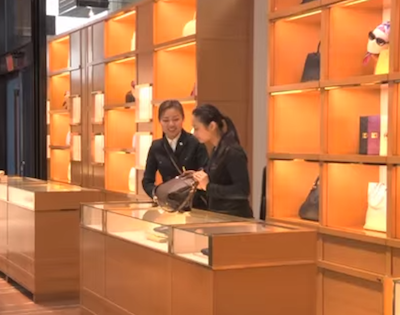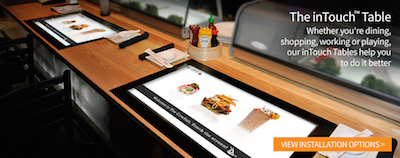Retailers must adapt to changing consumer preferences by adopting real-time retail strategies that deliver a more personalized shopping experience, according to a special report by Boston Retail Partners.
Real-time strategies that use the latest technology to target the consumer and appeal to her unique taste will help retailers be more successful. Ultimately, the goal of these real-time strategies should be to establish an enjoyable multichannel experience for consumers accustomed to online and mobile environments.
“The intersection of Internet and smartphones has elevated consumers’ expectations of the shopping experience,” said Ken Morris, principal, Boston Retail Partners. “Consumers have unlimited information at their fingertips and expect to shop on their terms – whenever, wherever and however they want.
"Consumers' desire for flexibility and immediacy requires retailers to deliver on this promise with real-time retail, regardless of the retail channel – in-store, online or mobile.”
Real-time Retail - The New Retail Imperative is a supplement report based on information collected in the “2015 CRM/Unified Commerce Benchmark Survey” from more than 500 top North American retailers.
Good timing
Technology has changed the way consumers are shopping and what they hope to get out of a retail experience. Implementing real-time strategies can help retailers better connect with consumers and establish relationships.

Burberry's flagship store incorporates much of the latest technology
The first step to achieving these strategies is to target the consumer as soon as possible, identifying her from the moment she enters the retail environment. This allows the retailer to personalize all further efforts.
Once the retailer has identified the consumer, it has the opportunity to pull information about previous purchases and preferences from a database. For example, a sales associate might recommend an item the consumer has been browsing online.

Customer service is an essential element of real-time retail strategies
Furthermore, identifying the consumer’s location allows the retailer to target strategies according to the environment. The weather, traffic or other environmental factors can be used to generate relevant promotions or customer service.
Targeting individual consumers with personal offers raises the question of privacy concerns. However, Mr. Morris argues that these are not a significant issue.

Mobile technology can be used to improve the retail experience
“Accessing customers’ personal information is a sensitive topic, and retailers need to respect customers’ privacy and preferences,” Mr. Morris said. “Retailers’ access to customer identities and profile information will be controlled by the individual consumer's desire to opt-in to a retail brand – or not.
“Consumers can and should choose which retail brands they want to develop a relationship with and when they want to remain anonymous.”
Ultimately, retailers should use the information they are able to collect to improve the consumer’s experience overall. The goal should be to create a seamless integration of all retail channels.
In-store, online and mobile platforms can be used together to cater to the consumer at all times.

Neiman Marcus inTouch tables will integrate the latest technology
Quick change
Experts agree that new developments in technology require retailers to adapt to new consumer preferences. Technology and the Internet have fundamentally changed the retail landscape forever, resulting in six major shifts that can now be identified, according to an author at the Columbia Business School Retail & Luxury Goods Conference March 27.
The world has become increasingly high-tech and high-touch, leading to a new focus on connecting with the consumer at the front end of the supply chain. This requires brands to cater to new millennial consumers by providing them with high quality experiences wherever and however they want (see story).
Many retailers are successful adapting and implementing these new strategies, however, some fundamental facts remain the same. While retail has evolved with additional sales channels, the black book of client information has remained largely unchanged, according to an executive from Boston Retail Partners at the Luxury Insights Summit 2015 April 29.
Providing a high-quality shopping experience requires knowledge of a consumer’s wants and needs, which can be aided and supported by technology. Centralizing consumer information and implementing systems that can recognize them across channels makes for a more consistent, agile purchase journey (see story).
Real-time strategies have the potential to appeal to consumers on an intimate level, making the retail experience easier and more enjoyable.
“Personalizing the shopping experience with real-time capabilities fosters the spontaneity and intimacy that are essential to deliver the ‘Amazon experience’ at the store level,” Mr. Morris said. “According to a recent Google survey, two in three shoppers who tried to find information within a store say they didn't find what they needed, and 43 percent of them left frustrated.
"Engaging customers with guided selling driven by real-time customer context will help retailers better serve their customers to save more sales and provide cross-sell and up-sell opportunities.”
Final Take
Kay Sorin, editorial assistant on Luxury Daily, New York
{"ct":"PBcdV2yiyuLB50hZZfyKzg4sg2UeDy\/J11rB4cfdUgDXPSli6UertXhETWM371kDQ7lo0eLTqjplLwcml33h2KfWdNaKQ37bDZM7OqwRmh6wTzGibCP+BfVk3dm4x7oJj7jx\/RjfBOonwXG5YFWIAd3+n9OqtfbRqDYpaJlGgXne\/OHdCRXb8HEHRlHgOJ4J9\/tqPkRQnHbmCAS3qBYOj0+JMZqE1oGh2SapIPDmPRNTD6W4D3sAEa6mZHvgHGXiZR0Tprud0jphzBWVrE\/jTRHVVcoS\/5v0F08do8G4mw7uoWFAldFiGn7eZBkEXX11AIAXYqYyReCtHy2TF\/wP2ujS2kC+TaxEEC9\/lgh8Kx3zbVRWWW5saP3P+nKFgfjv2fQJzGp\/RBayHqL9R6YrXVmpiu1cbXTFe2RMq4LZN9n7UACOSfLobgbNtNl1O26i2I8q\/oIhrkf4vc22724mCg9XL4ms6qBkNRJSH4K+sHoGj3Fqz0MC5hQuzAtbS3tSNfZ\/dkYpOFoulPxvh7LKYILMt5ZBEeSrfVDGkGjKOl5b5gEnYQRRhv50q3YzXGbi22ah5NfcAwZ3XGWXfXbRaMLLMSj533sQETPOC8fL8aErqjSYwvAFzuPNdYlvhbL82WzL0qzjFXWUmm7a730NCb64VewqhFKV7ll7C\/AI8kxnP6BfBsZubhMFXeg5x45n8QPgLzn\/j1CDK96Dy0xpDN+JEcc5kzPTQqEAB29pV+pw1Pc\/qu1OHxN+4AeQe\/6PPPCDlV84xzyO6X6erCMoBYILK5e\/xog1\/8s1TlecbYdGe8Rri3\/t+tLjMarRNOK5vHISKXiQKv+5QdEXJPqQoGR9eCf7gdFkuaJgEl++n9NsljkZwAvXZpa4YcVKdL3eu6MfFSGQ+1P3ZZYudkGQGYsYRq3e3lqfQEbYrTXdT6sTuy0UbQytxEx8HJJjz09Kte5YkP9vgExmXf9F4nvr8AYrsAA3eD\/oyK4JXBoY4soPvhr2xWRCvFx4VPz7nTbohotGSWq9BpidLfuzxnZWi925QE2V+vApthHewJKsl5FU7pXvHTfdVPb+ejF6boV1WRrTMNbItrEqzRDXTVrxjvCY6QTMWWeIq9+IykQVvn43tT5RAoTp765sK+Pc3MQ+nX7Qkw7K+Pjpo+21ZoY1XUEVib9P\/j1LEAQNB\/+JJQTYqelct7CpYH7D5p8P5trQdlF9OFsXvYK0HRPXqVtpjQZXq1331r4YaDDLtabUn8gXlrB4IIUF4vKfkxS43\/Syn7DLlbyIEuQZbZzrGzErhJNpWTX+FjByKk8FOb\/1L9JZ92IsfexmmeW86yj\/xRU8Bf2o8xy9KC1wLEIwSES\/s68QzM8moh8RPgJQFB2A\/azubmrLp7pJAzfR7cnuSDpCM5M47U4Q27NpL6Xck2wNA4Qx+rocVQCtEsr2HPVNAgZarTOqakgvZdzvAp5kElQe9LTXaaRRYQU0NyShZ5JzCBwH0D1kR3xYsvdzSA9WUU7iCjdsxqqIx2cLG1+aNyQHRJbmZdGoRJlcrVau9jIqUAtD4XoP0vHjOVt3XLC6MiiKw5DnEk7i7mtgjbp1Ax6xQCSsodITPLpj7qVJ+IlRTj4HejmqnKqAoqL+QVX+mKp63HPF+G04OwYfQKKH5WqQxfK8+VS\/vpuLPOr5uQol0NG5ORCBcscOnmLNV4B0sP1QgTtNRN2MMWi8oY9hDc\/EpeefvkeMibI6SbQgTlfr0w8n0R6dUiYyuKfrgfRGDW+h05aNVnlzTwJNzI2iBO3PmqeXUpiBFdro0aExBCYDGvnW38cz1GI5aR8mcdZDj87etq328wLEzo6bt5NXiozO0g5nMZ\/U56licgpWc1RBWKvu\/JjY88ur+KiQwzspseiG4Qy5Ul\/WNxRH6t5Ski0MEi2I31nPQ6Dx5FWF1Lio8\/+FPC8bPcs13as2kGsKUzbWrETDnFUdVUCvzBniwIl65RAGJNcrxUcotBveYoFqV2YZxAjPbpxbdVcS24Fbo7alTtmkmbGLOLlSZnolgCW\/Vdu+e2GU\/RrvrDtvcEfqvSXEd+dCUgi6zJC3qaq8w29Zf0KRurFEtSgx3\/74jyQ9pUjfDQlJZu7J0UXG+4Jc4f7eONLzchVmzSSKS2n7OJMl0K8ZH2wZk9NtLvxs5vY3Blm6mGrpJmUBmZQq7wydhcg3W3xhXTQlx4E2EaAJlKe+Rv9nUATdDtTY70WUS+KfgFrMj\/q9dSl31YUoHK+FUlMdjAOs+GcVNW5nuqWC\/bDbSuPTCMYP8wktuNriDBYWC8jgGERgUETIIKY0Lenuy2iG+BJUDTLpt3YXZovHh6vzobJ22lMw7GHYFdCABX4V3a+7r0qmFLWqoiDmSJvP1O2Q\/vWeifVTBE0Nl0at\/Z7V+7eZSxuzwi0hs8fzLLLLXK1SB5Gnc14w66kUTozO\/eGh8bN8GrltQWhpMyAZ4BGcSowt7frwtkItxFL0W45Q9D0I7ED3zroRUd3XgaNNaaGC\/Yaf\/fq5d6RTV4rjgY6z9xO54kox6D7vz7lbnmnXiqZ9kEjtdrQ2\/Girujs7OYalZMfnziMR4q4hH\/dDdfVNUtXSpdG4HR+Sal7p\/5Cn+NuBTW4G0CH1ONlsjRdwdTdJe5Z9IgcEmFrds2ui2gcoTpETR6w\/NbEBgCaW\/qfc5FRwHrXKeILTK0VMRpzirISXVmw9dNMY3CYXEXPAt1jPkd7\/YCS9MMCS7+y2d8JRd2QihMWCG9y2XYde7\/hFmwhXap2Prr9B9gq9IwS52xna0I0\/MZuH8jlAaDHxeV8q3MRW4o9ErS2ONbGRXf4YU8bC4Kocv\/hwHVHASBXMbfkTjwyHN+eqiQDSQLK3VyNu54e1PgnzHGmh6IudDcxtmTr54lMrO7KjQeCHG3SF9NG+nzZApEGgxwYb2GX0bo5FrmhvfUYUeZGC88npP3FagQG1WvnNxtwR5H2grusbWxIRB0lC6TQma54VihRPgsmZG+F9Q5fCyTYRde7K0rdgWi16XVPSETwSq8xvKLygeRykoBBng6y392VG\/5V7yaXRR5eRoL5oKIYuDiHlAckHMrWcxIJAePgS96btpfwaFDQWtRCncmAWM0XahIg6r8LLGR1r7x+3kmIj9CJIO8jbNow3Gw9w3IJ9JKIctwBIbOM4b5HwYaFhJ\/eu6RXDa9UUQsUGKX1rRu2YF\/6Nm5VD+Gz622a4LPIsiovfMM4sb4FUlMvxKNJf4uxWmA9fmt6lto4Dc0txs3tGL7UBeuZLjmkxibEmnWNfehdzn+1vHJg9OsSOR0f8F3wveP3ePJNi4Wjsf\/ee1o\/bdq9OvGtchrxgkgJLhIqGcv+TgkvPxmzGa9LfJuNOHXWaEHX30yCKTqdN6bx8s2X1xYhE8Fjt8dtOQ2BnaCjc6OF0E2SJPEiNa0gMXRAZgw3XjQneTYfO1ATXfDsEmq3P2++XTB5BiLYAWF\/uk\/SvAGuuTVUZv4g5NXhHr2K5\/FALZgyKsgGLRkbrBlniGwKD9QCdJaZug5SvHcqoLfpHDngsMStwCRR9I2oRQ4vjnm8u4IA20MpHCrfyou2PgLQuxY\/UV3j0yuSI7C+inOdxC9XtZGbGIgeyGeUhi49DmEWDWaX+YlxItsOdcU7GvDuwodCTnzo9llRNipuJQITbd2XE0XSjBGugG74CA8+ionk0zaBaTgaxI7EFTiy\/1oYukS0lEBxCU4kI\/KgieuPYNoxRBC5G3ZiFEXWt9EU0UEerAukwj8ffwhHPD3xN7HrceRC7x1Oo7EhgI+mdlYaq+0iJMIfMZxOaxF0DVvyffy+JHL19miEmTiqqCAhN9GaALncstj5KIqtV\/M7IGTlojPb4zVrIBurmwgrvsNi5FZCuwYU7prRQZiisCntv5RJauZzrKk75SH20MqGXYpKbfowhr8Ifxc828dv26HylT6V0a1qCQ5TEcjfRwd4prgLkRt6TVPuA\/8TR+4Z0NklKs0zhb9YdgiP8ZZ\/DLjczfvvn0VlFdcyf+x3readIBY0lv7F9WFHwUxKa0zvC\/+GKZab8nlJdFH\/aH2wC9QljxxdL8KUPjybrQEgcL2gbhoCx6yOwgOv4pY20VoDCBnLOuIIej0X1\/Y24DohBBvQV5GeQjkawJk+O5Rh9wNhT4x7VokGd\/WikkTlRsk9QQwT4vxG42TbRfaI0emVeX+I2aUNKb1f0SLk2T9nEGofzWQTViMOofJg4t\/sN6vIkzQOzPkpzogazvoAzO1\/Y1l0h0P21g1VQGK1jwXQsTbB59aJb4IH5XtkJ8nu8hlO6tp0zePYWAf3a1cdhO1PeYsC1i1sXWxGo\/jiu8VVbxM9UfRTPmgvmE8GEZlBvJtacKJ18Ln6UgQ1pnLTKZWoKlwpGKh\/6jXZ8MUO7azGzSpQ9d3JAH3Ttmhg\/0WzmA2EmBoTz8LXzXtJAl+2Lhc+BPNf0xFoXCSo5QkV1HeVy8e2zOm5EHt\/qznDN1YYtx5aWkWVIyvv0eDp+NFrrPdjA8tMkg3W1Lc\/Bv9WRB823GGIgombv4vXzC+rOlLrr3Y8IZTVbXMcWuO34BtgGszq9sxe\/Kkr0bKw67CqIaGLr8MQOaSubhRtJgt3eedXU5Gnm5zFJXdOmfe8KuoRw87VsDMW\/AVWb06\/TNPkKhyb3ZHZHMq95i9kBneJL0SP+Fi7vpG3BACbWmV8gXVb6tZB7E17qUZSsqHI+ff2Ag6Wu+0Nwlm6h1oCmAT7WfCMKt5u6jLy6XClcoZ\/XYVw49Efe5k7lZ\/JEWjq7R0pOYy0Lj9FJO6tg3Sk8hwV2oCg+gvo\/sYeE09aC76Lr4Dk9y\/SepOgHB1vH6a004DHDonruMjkNOAaSY0hV\/qrbTgXUTAsqD4o65B3JBbrQ\/4dfbFx5iTMITrcSD2WJSO+5GynlQ6k6JGoSCaMHdjZT6nl6b4+v4vEZAgAEdIExANDFuRhOm3xnX3\/Bux5rFfGeDRLpQ90JAmSKm0HUsMZLgmLwAsZlnglvklw9Lvs8W\/6+PuWpuG1Y24nwgWdHNxG36rP\/PTMCQ3zKJQGi4QITI5foJZtdje4\/o0NlveUVIIRf0cD8kUwWfvuSo8KcIiNqb6h\/EYzZAMPgLCb5PCPHXdKCXjRdubh9IC1ebBz4vSQXk\/Xw3GOat20yWatz0VsjRVQ35lK4bHz4U+2JwWEUqgavaeHSFvqBl8BepXxcSsDx0rN38GisjRMK\/BcBM54pJszhEIXwTCIDftxY5BLA5\/6Rl2MiTc0\/2joFB5RpameJ\/hnRZhpr24fd9D8W08Tg688LC7lGoT8XGI6NR9BNvCnnNCtBYw5ymMPHD1NdUwT9Coputye3gc4dsOxxz3HgCgnSmFDElIKZq2IiTwq5UjWBCyjBp57vtLZRV63CxqDAhulQ9+fpvk3L5OhxAhq5CvINwQJxEum0NbkSK7tG76ZZDu77CeU27Wvg3dpI\/GwXR1gDbTiq6g6ZMLkPt\/AX5dL7DrZ\/8tySpgTHYbQPCCltAWD1IWJNvBik9\/6M4zk95PtGksw1wQCk1NjMZhTS04zfQkwr9RffLXTgJy5fD3mccJeKqPfss9kh8GXgDsPXqVeQlGmY2oKXrcQPOaucplRuK7EFIe90kTAQ9xcM79WLaD+tOJxWLLanlJJLBvzmw5KBggsWVBLqmYucaAuwn2C6pfYAhnLNsU4SlQpc1348wMhyfIamBs0b9CoGr13aYv+ZT8S2cWHluKk7vsLuWNp02pIC8wxwVEQTelc4NPWvtY7P7sfS2QUPySwZq5gvRBKShf4FfWbm7OuQbG0rLOxVs0TBwCeQl\/Os5nzPiUwdA+5CIXkZKKMVP2OtTBvBb1rA2dO\/lelT7QWsEGKDNaIdjEM5Ozjl41X0EoCxD3hcr5+oUQBe\/hiMHLjcpBROoMWxMcSck\/vwDjKAIBKcuEwf1UYxQjWWxiYAUef7AkgLiGXWS\/7uDo7DJFQ74lB6lXYaDDykFx4DTnhuIxJ7BNQ8YBTsqXp4BMZRDO6Gqcxr7pJhYb6fWQsvCyEZykEVc0mxnAR48+JO\/JtXvu\/8jukd3sMOgFQ0os7sOBlmcToYZJsUbK\/tWvMZz4e2xX02u98fjOjvEUccOqeb\/v\/rAgqCM1BQQNGngTSpD0zNTABWbEBhLPlZonJNJcch+2CMMuTdgFHip06mkNgwWenot+f9GghOhAkVDyddCUG\/sX\/6zGm2FT4Iq2zGi6uPnSnS4SDLMsrHzLeenB0BXLykPf1+LnY2qdq2m\/nbCn9dXHcziZ81TaLS5XZrPs9ojZW8d3S0garba0Pwakl3W\/XD1fFB\/l9QoUVaKD00ZA\/cth\/qq5Gi\/ZpMVtiFfYUG4ffWRxpaj5z7gV6fY4\/HSAKHB0a3EPV\/wtuh94vn3QZb8NQ3LXFhQTP2FfuzRgQ2AoLu0RPQLNxrkxK8BV6uSlrLqf\/TehUUzPnN\/kVe4FgOwWa0h1GQpMhDBasolwBEc1L79jdcynIJAScEDAk2b0xseMk0IGDKS14\/fBb+sh2Vz4bThTpk0DoRohO\/EcKus3U5TnSkhGqs\/izwA52xiD6d4\/hqcpFgPeWCRQ9Z39EdP+PQ7KkpHHK8J1nQum\/LgKY8zvC4h3EzIt0x7gyB+AEFGkTf55SRErNICxGfe9YuqvS5xm+oa9cq5NqbAVDGLrlAUsMXBjlJAt8F0bzr9f+jbzsW1ORTz6fF8XdO4OAG855o7ET\/WiMX\/qdej\/5bpxQ0DiDvIC2GfQDNBDsLmmsg9J8DzKGqT3WFzLehAL\/oq92BKvNKRuP\/PIQJz2VKcCwanrt2tgVmQH8UlYx7SnpYrdctgjwtiU4gVSiWbkF0JCQhYUYHadn7r0WU76KVtI6DL8ZTZfiqdJtQuRpMWNh0TSRsaOwYS9t2f6Pht7ytaksuEBQS5IozZrCLklyRl\/htPaupBJkO8WhoQpnTgMErdKpd+0kAjKYpu91gpwfNcOGDGmGkWJAYyLOfgxFw4V8NAVnqcir2DRFMsLL\/1sq7\/tm\/NbHgj3rROADjcmh3ScJQ0GLxJM+XLVosPFn+CBvR1OXxgsWumAafTE\/44BRcTlShpozWOUy4QgRix4IVFMSuJC1vNUPStCvzrPsCRWkP+s4y7bTlS8bp2D2TgLA2s2D86cWvC5O71\/\/2y9ydpqwH7W8qsOtcbdSzw9YC1WL0NC5jVUxmmbiZQj5G2ch36wkDJCugMmiQMeeN7bOZURJfmaxqbNsfUNS1z3thRcZdm1TzJVwDwVdwWixxiRhZ7USvQQrLO9Jt6tXQ5bGURjzT8b+Ftmjmy1916FdEWhNrC3MSARWDCXkVhg2wJOiKIQ5vIHafAW6UTQ5x6PqfBheUijbDG7j9A1WMwfPYVIF8Rh0FAG0dF6vpeSWT7Lb+QJNnyJt7IfpjzclyfH6t6mp2rQWBuwcdym0AclVV6uKGf8QPuVRPSBM4gBrpvlar8HKOOxXTvn6l\/AUVSZCiDOhF8nbwqkwoI89lBp8LkLuhimXgITPhDgH6pulJZv9SMdk1999GAez5Sl6SWhHTHJ2UxD7PGbOaqi5BSTFIY4r8fuBBGl\/uH0\/FpVPflH5P1NKmDcT54mLG4t24jR82JFAHi83LPjqIVzshSWIpuZrktvH2APsVP+9Nah2r8USnsVZpBD4XLpSqnAQnSRVNaOcS6Qyh4hJJRo8a3vVzPK\/yavlirYVsc1z4xfo2\/XyAoL78ERMEzP28PZIIzZjRbC0jWSKJBrn45f2+iCX7RJLsbd0DAjXX4ezy1UJEX8dmJYOvI\/\/YSpaf0BrMPmPTfoAdIwk\/+89yXfIrkWWbJ3f2fgf++4QmYvwLBtdFkm74pXmJK6S1Jpij5DRBzDt2Bhi1Q2xL1mGRqLP+TldFmJG4vXSl8kRZ5U645zOLQbZpojOfp9FOGNceHa120iZlOtcEFzB4DyKUiTZH4PHph7GZkdeRJH+0x3mdQrGJ1xQDUBoSXhNBnA77QromF8kcZ+fl5ZpjZFVfY1fJGcERRS6Et7UkjMabBMS3wuvQdjsVVwv2Ls89mVkogwEknCADS3Wtl9EGy6IxlWfAgaRqjvCFTIb4JBjmb1iZ+j3QeGerkfT7Hbwnuh\/M9HX0J1HyB1llSlzaei88MHbeQJ3Cx1XLmyKIU5VqIeicMY1fSjTVXYNUNdU4AxcYKCjF8aVaL4iThqGOnDOlAzOW0IHTJEF\/2nj0CS4lq5M3zcERBOUZYIkqdHqSg7qlWa48AbO3PDsVu5pOx2++3PuNFoR56Pmb+YS1gkI3p763exyP+mj+GWacdCVoe2vH\/1N6MZz4G2RVxrQFjBucwNqwU59IeE9ebbrVR75kK1Ic3FqqJfFU\/R9\/V9AtEhZiGFGF\/JkXHkJ309FpjlT\/GPCoJJYteUOCIkRUZeI\/L7wcUFQeoObqAV3dCTh1oXyAl5kqgdD1N+OPiFKPugC9ZcsSyjL7RlC4wcAawSsGboLdw2epfy2LQknjCKwKLXGCsPRdTNhEcwRVVNtGCDfYkVwIJnWHuupLrQb85ljCr2qg+lIi9LdQqLagADYL52+BlxIejjfAgSLooXlwJ4S4YCSYt7+lga43wK24gTqkQeVMigC8uXSkPYgs9xsAqvzAT\/r7W3qAiMEzJQh1P9VzzNhLclry67GK\/lziUXWVyNfLTizXUDl4hoEUZzHcprPcpmp5PykS5JcsGAWf2HDIJ3wCTMUqvjISdDNLLhV0ZsSqN46XomPmieI5CPdiOvJcOeW2PwM5Pqig2AzmdnJr4pB7RxvmoZSHieHpwHKJEsy6Wd0wWqrvZqt3KpAcIWuVPLKORJX+rGOvePWIGOhKD6sJMKNxwqciwrioOj4CGDdvLsRyrXZRvUOyVh\/xJovPrd+AHVDTjkiUfqJXaE91wUTk1hN7Frgx6FGGEIGRcYANGPTkYPExEOJVWItul\/VQLmBdZNsJ77RvNZF3cI+hAbnQFGiDxgH8BluYvpzk\/2u9cP4a70nFSM1KynQYVocAKbrb51uv03eCOnYJWILpg2sJCoLeiedH9kp9MJPX6\/c6EDs0x6Z7q8RW5Q2Y5Rwb3d4Rdi32FdyTJF9XY7Fd2D8+k8\/1Sfrr\/psvgIPOdHeq9XAdblCrk3Q5UDHf40OP6v3EMZK385TnyJkKarx42T3GlYUiqcMPNba3AsIdRokjmfHXy6hVbW75oii5aBwqTmFZwOWyQKVXwKANErVYsfZwWozhw+JcHfwOBOBYTAGkEr6I\/XbkWFYcbyGXQ7Z1xnAj0\/uvuuYgFkmlIaGS4bIlXK4UNtLp2Wk4YgJ3df0ERhC\/bdqgYnpRdvsLigsH0bBOvbZ09A\/srVBKmpI2RSn854pGHd2juul386qDr9oBI6AXtd3CfGg0y4lqaQU\/FK49CMGhX1\/tq+JPn+VFlNON0Qw2WpLIyhMBJn3OMkma2UsvOvOtS5cuxcV6lCgB7lsGddA2D6TRORKdZbR+rOswDm0PL1OyJtIEQ9bb2JcmmXKscuHHeWKpz4cRHWi24emESfdeiSvA8p4OFAI96aCAw85Jm6swIR5g+RoiZgkJXpklv9U4fhZXWgfxsn9lrz7Ij94IOjkkTEsfNq\/TyOUyVzRTA9vgYffOwGjAHYO3tfNaDQxTWQ6TX0H9mSYAlgT5VSorPGleuTXaZNmk5GPWIHXZ3jILA8GCDVOYxCzYSM6y2rhv0PHh4HwRi\/K0D4i67Atjh6ACSzYRA9HCbgnirdxR1PbNJoWxa+EchSt5AL6KlM4K8XqUi0uYohR1RP4+bFEr1GKomI3zUKBW9OplmDj+vY7rfvhrXv3DIa121zpbloSevS17AqV7Ff3I7FG+DlsmQFoaqeIR2ViYNqy0HQEX7OZdw0Zbz5GrTWow02wPBK8fjTvbbLdbq\/5me+YgZ7d4guvkYiwBO1AI+TIvhPUHKJQ71I4cV3Lz82W0PPRGpFupMWM0D04RD3t4u3j\/FXhiND97sz\/NHnWfXK2Sy3m+qroMZ6lPwX7KejQ\/KOL84SjYmmAoDueN2rKtq5iY52H5DDkyymnrPukhsodzr3Wde0lemWy2urqiM9mf8rPNDFftYPva0MoEBCXN42JIOXdkXKuZGglpTQWcjfYD9R4E6cL+1Bh6e\/BJh8oiAfHlpAhCZY9N+hfVDfn1AQUv8vTane0tSSAsQFBIo9Sj2bFwwX3MgLOTOqr20sVTYOecjfpkT07W7dg2pkBHhTSdjfuWmsCNrrFD5tKNAvUk5ogiiwy2m5z+Ad3fIyUH97kSccedH5QA6exjqQUimIH6pfcb\/16O6qix\/ojCmF\/2cRSX3IdsAee\/m4V0juUPteCCZRuRrh9jOd5X9WOEBm8WxcCkzH0DB2vfuKgwndEcbTLm9OQ0Tyn4J2xWQJyUXQl5+ax9hXhQxKNYq\/dPVLq2r0Y6ixWkB3GiFMA36raSNa6j1a87DzKQDfe4ZtzhhRDp6D38","iv":"5de51835d6c5889e1394aaf714da8361","s":"86b9b04ff718472a"}

 Value Retail promotional image
Value Retail promotional image